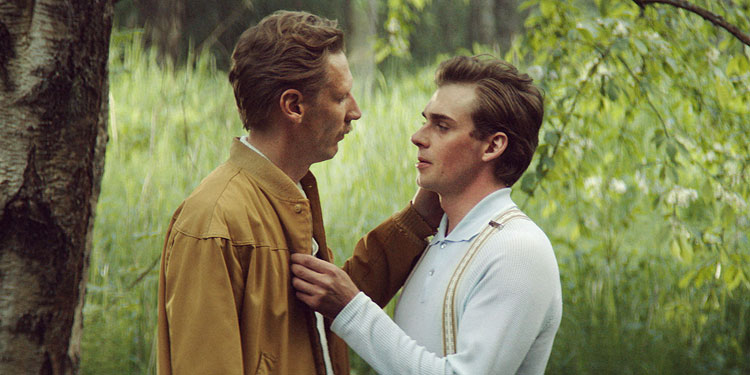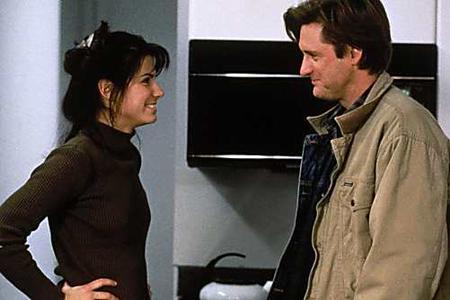Film Review: ‘Tom of Finland’

For a couple of years duelling biopics of Tom Of Finland were in the works, but this is the one that finally made it to the screen. The life of Touko Laaksonen is certainly an interesting subject to take on, and there are many ways it could have been done. The route they’ve gone down is to make a fairly traditional, prestige biopic, which is perhaps an unexpected choice for a man who made his name for outsider homoerotic art that defied conventions of both sexuality and class.
The film follows the life of Laaksonen, picking up his tale just after he has been discharged from the Finnish Army following the Second World War (the movie rather bypasses Finland complicated position in the conflict, other than that it was hell for the soldiers and also helped set off Touko’s love of Nazi uniforms). While he had encounters with men in the Army, in post-War Finland, being gay is still about furtive and dark meetings in order to avoid society’s rampant homophobia.
His situation isn’t helped by the fact his judgemental sister, colleague and roommate, Kaija (Jessica Grabowsky), doesn’t know he’s gay and doesn’t want to. Tom begins a secret, long-term relationship with another roommate, Veli (Lauri Tilkanen), but while needing to stay deeply closeted in his own life, he begins trying to find an audience for his stylised, homoerotic image of enormously well-endowed, uniformed men and motorcyclists.
The growing success of his imagery – done under what becomes his brand name, Tom Of Finland – leads him beyond Finland, initially to Berlin, before discovering the ‘anything goes’ world of 1970s California.
It’s an entertaining and well told tale from award-winning director Dome Karukoski. The film has a nice eye for style and history, and keeps the viewer pulled in as it illuminates the life behind the iconic imagery. However, other than some surface observations, those hoping to learn more about exactly what it is about Laaksonen’s imagery that caught the gay imagination and continues to appeal today (despite the proliferation of far more explicit imagery), may be a little disappointed.
That’s because rather than exploring the artistry, it’s more interested in cementing the position of the artist. Indeed, there are moments when the film gets a close to being a filmic essay arguing Laaksonen’s position as a key figure in gay liberation, and not just a guy who drew some prurient pictures decades ago. That’s fair enough, but occasionally it takes this a little too far by pretty much suggesting the whole of gay liberation was down to Tom Of Finland. Indeed, the whole section of the movie after Tom first goes to America doesn’t feel quite as disciplined or satisfying as what went before. That’s partly due to the fact at the start of the movie character underpins everything, which ensures emotional involvement in the prejudice and difficulties Touko face. However, later Laaksonen becomes increasingly secondary to the points the film is trying to make about him and his art.
Even that could have been okay, as he is an interesting case study in how the meaning of the art and the artist can be different things – especially as he ‘hid’ behind a pseudonym – but the movie doesn’t fully address that. Similarly, despite being about the seeming disparity between the closeted life Laaksonen had to lead and the open eroticism of his art, the movie itself is sometimes a little coy about the sexual side of Touko’s life, especially his interest in different fetishes and S&M.
Click here to watch the trailer for Tom Of Finland
The film will probably seem suitably risqué to straight audiences, but gay viewers may feel it’s slightly holding back. Indeed, there’s are argument to be made about whether this film is essentially about the gentrification of an artist whose entire raison d’etre was about the fact that what he drew was so far from the gentry in terms of subject, style and class. Indeed, the movie’s frame of reference ultimately turns him into an oddly establishment type figure.
There are undoubtedly things that are problematic about its rather traditional/mainstream take on its subject matter. Admittedly, dealing with those problems would have probably made it even more of a niche film than it already is, but it leaves a movie that is interesting and entertaining, but feels like its missing some key aspects of its subject. It also gets a little messy in its desire to show that ‘Tom’ was important and not just a footnote in gay history.
Overall Verdict: Well worth a watch and undoubtedly entertaining, even if the prestige biopic format means many key aspects of its subject fall by the wayside.


![[Gallery] Maya Gallo From Just Shoot Me Is Completely Different In Real Life [Gallery] Maya Gallo From Just Shoot Me Is Completely Different In Real Life](https://images.outbrain.com/transform/v2/eyJpdSI6IjNhZDJlMmU5MDYwMWYxZThmOWM1NTBhMmE2ZDIyMTEyYzg0ZDNiNDhmNWExNjk2MzYyZGRkZTg1YjNkNThjYmEiLCJ3IjozMDAsImgiOjIwMCwiZCI6MS41LCJjcyI6MCwiZiI6MH0.jpg)
![[Gallery] Wife of Fox's Tucker Carlson Breaks Silence [Gallery] Wife of Fox's Tucker Carlson Breaks Silence](https://images.outbrain.com/transform/v2/eyJpdSI6IjQxYzExMGQ3ZjMwZjNlZTU3YmU0OTY3MTAwZDcwMDRhOGYzYTEzMTFhYWI1ZmM5ZTY5MGVlYjI2MmFhNWI1YmYiLCJ3IjozMDAsImgiOjIwMCwiZCI6MS41LCJjcyI6MCwiZiI6MH0.jpg)


 It’s been a great year for gay-themed movies at the Independent Spirit Awards – the gongs giving out shortly before the Oscars, which acnowledge and celebrate those film made by and released outside the Hollywood studio system. Leading the pack is the acclaimed Call Me By Your Name, Luca Guadagnino’s movie about two young men falling in love in italy in the early 1980s.
It’s been a great year for gay-themed movies at the Independent Spirit Awards – the gongs giving out shortly before the Oscars, which acnowledge and celebrate those film made by and released outside the Hollywood studio system. Leading the pack is the acclaimed Call Me By Your Name, Luca Guadagnino’s movie about two young men falling in love in italy in the early 1980s.

 Nathan lives at home in this small suburban French town with his Police Captain father Stephane (
Nathan lives at home in this small suburban French town with his Police Captain father Stephane (

